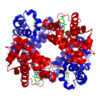Everything posted by Theophrastus
-
Pictures of your lab...
Not a bad point (a rather noteworthy one in fact:-))- I suppose I myself have fallen (initially figuritively, however following this sentence, I shall make it my duty to slip off this chair for effect). (Ow!) I probably wasn't thinking straight (as if I ever am) as one would think it to be common knowledge that large magnetic fields, and external electronics equipment don't go well together. In all honesty, I never thought about that, however, the images I was referring to were only taken when the collider was only undergoing construction. Ah well, when all has been said and done, I suppose that were stupidity material, I would implode under the strength of my own gravitational field:D. Alas...
-
Home Made Sulpher anyone?
In regards to iron from cereal, the yield is absolutely woeful, but the fact that one can even get a yield, as substantial as a ball bearing with enough cereal, is actually both creepy, and yet utterly remarkable, however, attaining sulphur through food, is absolutely pointless. period. However it's a rather easy chemical to get a hold of, so I really don't bother to make it from scratch. Even sulphur crystals, are pure enough to use for basic experiments.
-
No, you CAN'T make sodium!
Excellent choice, in stickying this point. Everyone I know, when they first start chemistry, have a taste for things that "go boom." Metallic sodium is one of many of the compounds that go upon this list. The other alkali metals, acetylene gas, and homemade 90% hydrogen peroxide are among other sought after compounds, that are not as easy to make, but seem to be much desired. It's interesting, that everyone seems to have a natural affinity to using electrolysis as their "magic bullet," as you fairly pointed out. Certainly a worthy topic for the psychology thread.
-
Pictures of your lab...
I'm actually rather interesting in the LHC!
-
Pictures of your lab...
In regards to Severian's lab, I must admit, I am so impressed. You work at Cern, in Europe? I very quickly realised the pictures as the classic images of Large Hadron Collider, that's currently under way deep underground, in France and Switzerland. The biggest collider yet. Pretty impressive... either you are fraudulent in nature, or you work at Cern. Do reply to the following. If it is the latter, I'm sorry for the accusatory tone. It's simply that I couldn't help to notice that those were the exact images that were sent all around the web. They even featured in a National Geographic regarding the new facility being built there. A response, perhaps?
-
Does anyone know an easy way to get calcium carbonate?
While it certainly isn't a lab grade quality, eggshells are approximately 95% calcium carbonate, so if one were to powder the shells, by means of a mortar and pestle, being careful to peel off the inner membrane first, one should come up with calcium carbonate powder, of a relative purity. I've tested this, by reacting the remaining solution with acetic acid, and it works quite well, however there does seem to be some organic residue remaining, a testament to its relative purity. You can also buy it as an antacid in most drugstores. While I am unsure in regards to how one could extract it from limestone, you can test for calcium carbonate by reacting your mineral extract, with a strong acid, however, while reacting less vigorously, weaker acids, such as acetic acid will suffice. If the mineral seems to bubble, then you know that there is calcium carbonate present. (example of the emergence of CO2, following the addition of a strong acid, such as HCL) CaCO3 + 2HCl > CaCl2 + CO2 + H2O
